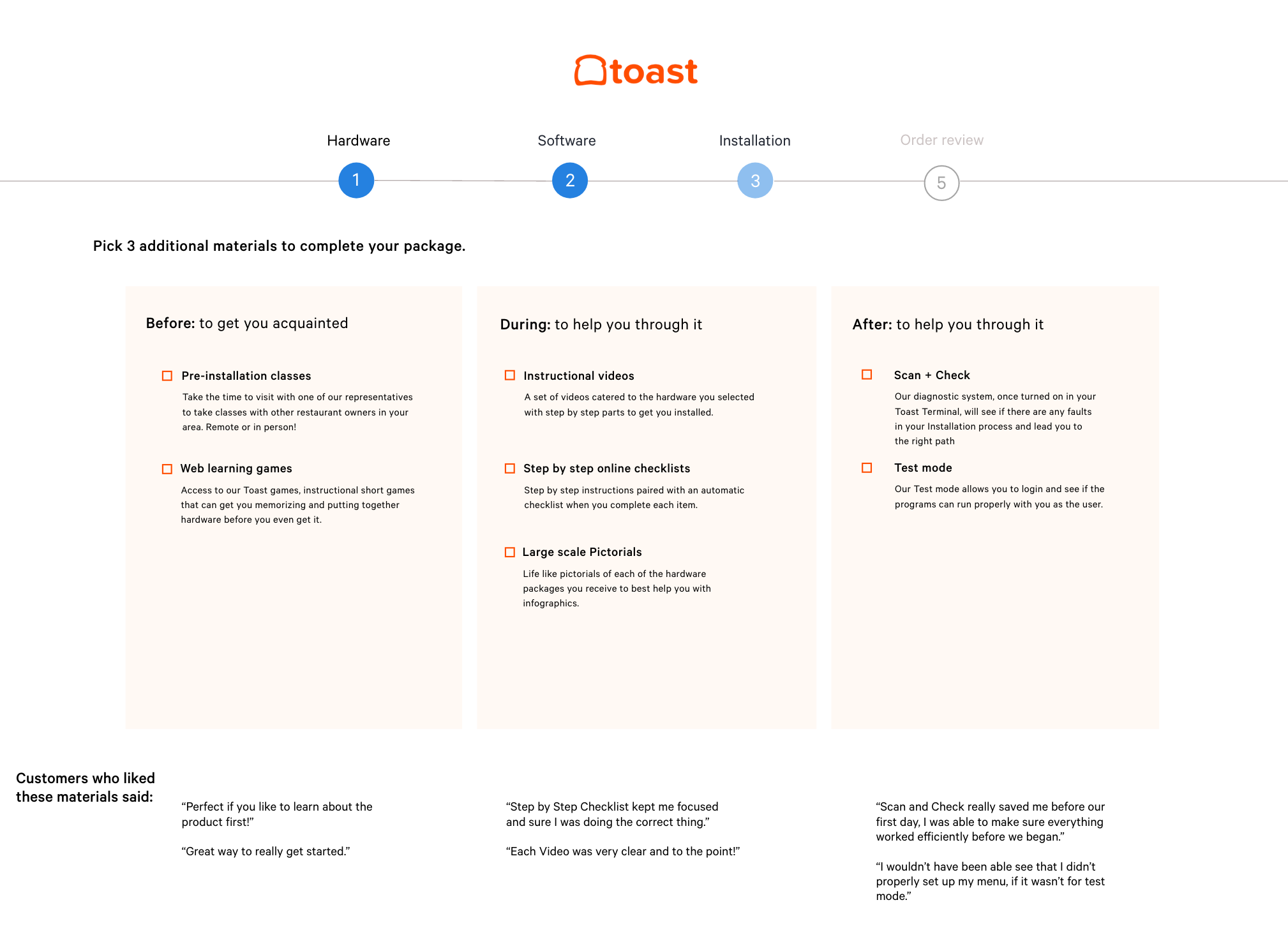Toast On-Boarding

Toast On-Boarding
On-boarding With Toast
Role: UX Designer/User Researcher (Solo Project)
Duration: 14 weeks
Tools: Adobe XD
Context
Toast is an existing company that sells POS (point of sale systems) to restaurants and other retailers.
Problem
Toast wanted to reinvent their remote on-boarding experience to be more cost and labor effective for the company.
Goal
To discover the pain points of the customer on a physical and virtual level to be able to redesign a much more simpler experience.
Process
Research
Audit/User Research
At the beginning of this project, desk research was conducted to fully understand the assets Toast contained around their on boarding process. After I was able to visit the Toast Factory and was able to see what information was brought into each of their packages. With this, the next step was to conduct interviews with Restaurant owners and members. As well as to hear what the existing UX team at Toast had and what they were pursuing at that moment to better enhance my own knowledge of their on-boarding process. This was all done to be able to better grasp what the main pain points were for users whether it was opening up their hardware and discovering very little information to guide them or if it began earlier in the process to where they were buying the hardware. With this being done, I was able to note what needed improvement to better the situation for the client. Below are some insights from the research process.
Insights
Each Package contained the same information and pamphlets.
Toast provided an online portal for clients but how would they know about it if it wasn’t searched?
Toast was pushing for more remote self installations
Toast staff were supportive through their over the phone installations
Users weren’t able to purchase more/pick more materials for their remote installation process.
Users felt that they lacked power in the installation process.
Customer Journey Map
Using this I was able to move forward and develop a Customer journey map to gain a better perspective of where the map pain points were.
The main pain point was at where the user was receiving their on-boarding method choices (Remote installation or on-sight) without the choice of seeing or picking their materials to aid them in the matter before getting their hardware.
Analysis
Moving forward, I wanted to address the issue of the lack of materials the clients were receiving in this process. To me, it was one of the main issues and pain points. It prevented users from having a fluid on-boarding process without needing the aid of a Toast representative to guide them as well as through troubleshooting.
As well as focusing on this issue would benefit Toast’s goal in pushing their clients to remote installations. Remote installations would save Toast thousands of hours and dollars that were spent in labor with onsite installations as well as on the phone guides in the remote process as well.
From a business standpoint, pursuing the lack of materials in the remote installation would benefit both the user due to them being able to save money by picking the cheaper package plan of remote installations as well as it would save Toast hundreds of thousands of dollars from labour and travel costs.
The Three Concepts
A checkout system: The user would be able to pick which materials they would receive in their hardware packages.
A Personal Quiz: The user would be provided with questions from Toast to discover the best learning/installation materials suited for them.
Progressive Disclosure: The user would get a standard amount of materials in the package but access to links and QR codes that would guide them to additional materials on the Toast Website or other platforms.
Choosing a Solution
Checkout System
After weighing the other options out with my peers, this turned out to be the solution to further explore. By continuing in this direction, it would provide their clients with the exact materials they would prefer and save Toast labor time and costs on the installation process.
Prototyping
I then moved on and took the existing Toast shopping site and added a section where users can add up to 3 additional materials for their remote installation.
It would display your selected materials with a description and how you would receive them.
Here is a video displaying how the user would use the additions to the site.
Usability Testing
I was able to conduct one round of testing with two different groups of people. Within the groups were four participants, the first group containing restaurant owners and the other with people who had very little restaurant experience. They were both provided with the same prototype and I asked them to select a remote installation and choose the additional resource materials that would go along with it.
Feedback
Easy to use for both groups, well explained.
Users generally liked to pick out their own materials.
Users weren’t sure if they could pick more than one from each category.
Reflection
Through this project I learned how important the User research process was and conducting an online audit of some of the additional resources that Toast provides its clients, such as Toast Central and Toast University. Researching what was already present and talking to people made it clear what the exact pain points were. I also learned how important it is to keep an open mind and not to rush to the first conclusion. Fully exploring the needs of the users allowed me to really explore what could be the best solution.
All in all, I was able to conduct research and create a prototype that would aid in improving their remote on-boarding experience. By developing a solution that would increase customers selecting the remote option it would allow for Toast and the customer to save money and time.




